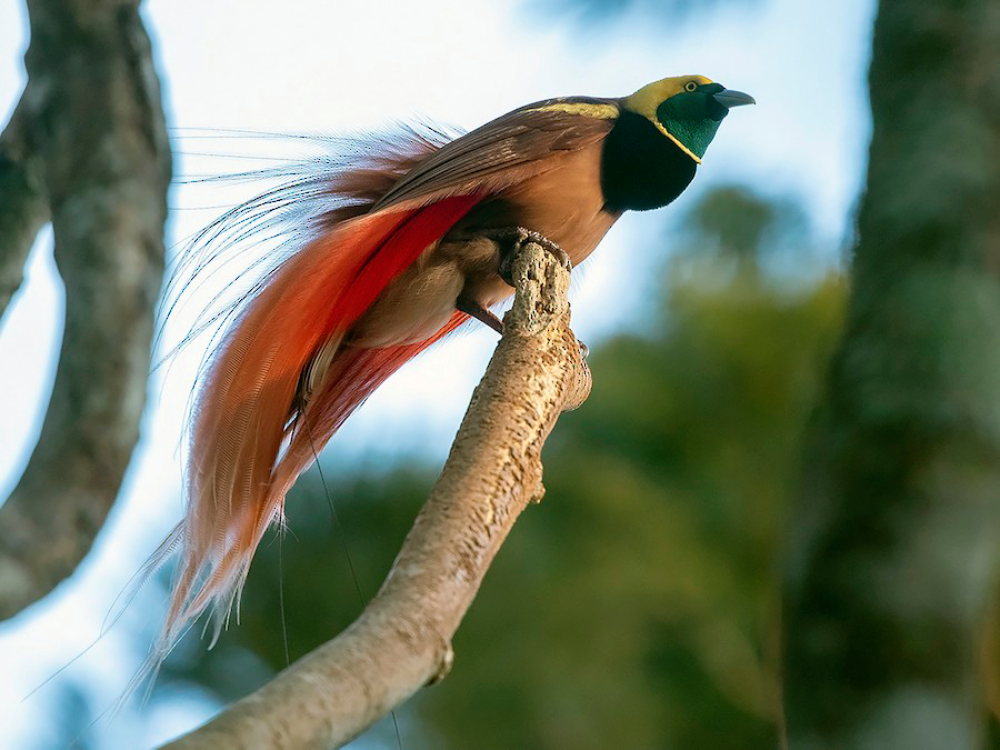Taxonomy and Naming
This breed is a member of the Paradisaeidae family. That includes around 42 species of birds. So, these are popular for their extraordinary feathers and complex mating rituals. This particular species was named in honor of Marchese Francesco Raggi, an Italian naturalist and patron of ornithology. The bird is also commonly referred to as the Count Raggi’s Bird-of-Paradise.
Physical Description
Adult male Raggiana Birds-of-Paradise are particularly striking, with their elongated flank plumes that cascade in shades of orange, red, and maroon. These feathers, used prominently in mating displays, can extend up to 60 centimeters long. The males also possess a distinctive yellow crown, emerald green throat, and a crimson cape over their back and wings. Females, in contrast, are less flamboyant with more muted brown and white plumage, which provides camouflage from predators.
The sexual dimorphism in this species is a classic example of evolutionary adaptation where males develop vivid plumage and elaborate behaviors to attract females, while females remain inconspicuous to enhance survival and successful rearing of young.

Habitat and Distribution
The Raggiana Bird-of-Paradise predominantly lives in the lowland and hill forests of southeastern Papua New Guinea. Its habitat ranges from sea level up to elevations of around 1,600 meters. These birds prefer dense forest regions where they can find ample food and suitable display sites for their courtship rituals.
Diet and Feeding Behavior
The diet of the Raggiana Bird-of-Paradise is omnivorous, comprising fruits, seeds, insects, and small animals. They play a crucial role in their ecosystem as seed dispersers, contributing to the maintenance and regeneration of the forest. Their feeding habits are generally solitary, although they may occasionally forage in small groups.
Courtship and Mating Rituals
The courtship displays of the Raggiana Bird-of-Paradise are among the most elaborate in the avian world. Males gather in communal display grounds, known as leks, where they perform a series of intricate dances and vocalizations to attract females. These displays involve a combination of rapid and rhythmic movements, including hanging upside down from branches, spreading their spectacular plumes, and showcasing their vivid colors.
During these displays, the males also produce a variety of calls, clicks, and mechanical sounds by flicking their wings and tails. Females visit these leks and observe multiple males before selecting a mate based on the quality and intensity of their displays.
Reproduction and Lifespan
After mating, the female Raggiana Bird-of-Paradise is solely responsible for nest building, incubation, and chick rearing. She constructs a cup-shaped nest from leaves, ferns, and vines, typically placed in a concealed location within the forest. The clutch size is usually one or two eggs, which she incubates for about 18-20 days. The chicks are altricial, meaning they are born blind and featherless, requiring extensive parental care.
The lifespan of the Raggiana Bird-of-Paradise in the wild is not well documented, but it is estimated to be around 5 to 8 years. In captivity, where they are less prone to predation and environmental hazards, they can live longer.
Conservation Status
The Raggiana Bird-of-Paradise is currently classified as Least Concern by the International Union for Conservation of Nature (IUCN). However, it faces several threats, including habitat destruction due to logging and agricultural expansion, as well as hunting for its feathers, which are used in traditional headdresses and ceremonial attire in Papua New Guinea.
Conservation efforts are focused on habitat preservation and raising awareness about the ecological importance of these birds. Sustainable tourism and eco-friendly practices are also being promoted to ensure that local communities benefit from the presence of these spectacular birds without harming their populations.
Cultural Significance
In Papua New Guinea, the Raggiana Bird-of-Paradise holds profound cultural significance. Its feathers are highly prized and have been used for centuries in traditional ceremonies, dance costumes, and headdresses. The bird is also the national emblem of Papua New Guinea, symbolizing the country’s rich natural heritage and cultural identity.
Traditional myths and stories often feature the Raggiana Bird-of-Paradise, reflecting its importance in the local folklore. Conservation of this species is not only a matter of protecting biodiversity but also preserving cultural heritage.
Scientific Research and Importance
The Raggiana Bird-of-Paradise has been the subject of extensive scientific research, particularly in the fields of ornithology, evolutionary biology, and behavioral ecology. Studies on their courtship behavior and sexual selection have provided valuable insights into the mechanisms of mate choice and the evolution of elaborate traits.
Researchers have also investigated the ecological role of these birds in forest dynamics, particularly their role in seed dispersal and pollination. Understanding their interactions with the ecosystem helps in formulating effective conservation strategies.
Conclusion
The Raggiana Bird-of-Paradise is more than just a visual marvel; it is a vital part of the New Guinea rainforest ecosystem and a symbol of cultural and biological diversity. Its vivid plumage and fascinating behaviors continue to captivate scientists and bird enthusiasts alike. Protecting this magnificent bird and its habitat is crucial for maintaining the ecological balance and cultural richness of Papua New Guinea.
Efforts to conserve the Raggiana Bird-of-Paradise must be multifaceted, combining scientific research, habitat preservation, and community involvement. By doing so, we can ensure that future generations will continue to witness the awe-inspiring beauty of this extraordinary species.









